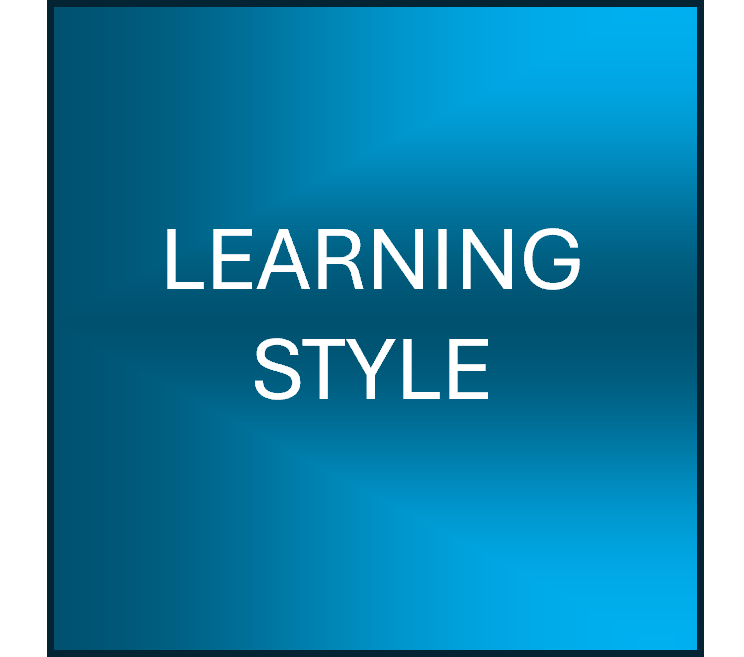
Item 10 of the 17 Competencies marking sheet

Item 10 of the 17 Competencies marking sheet
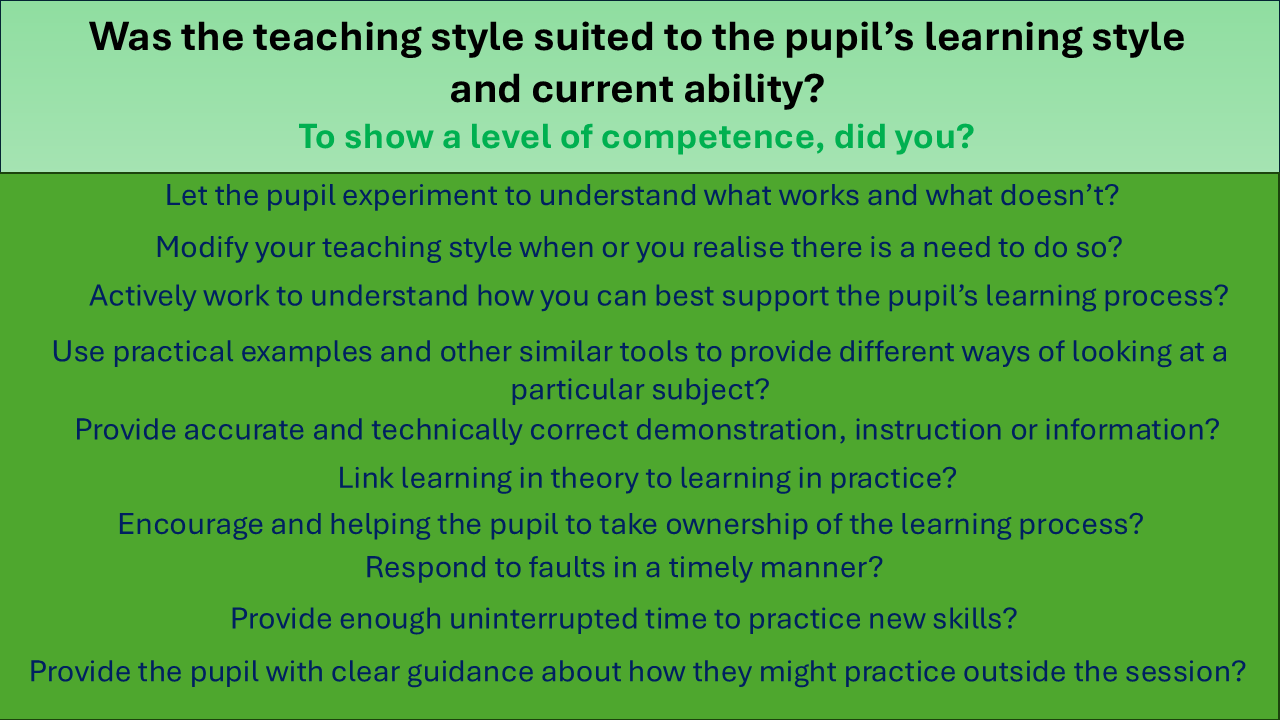
These are examples of what you should be doing
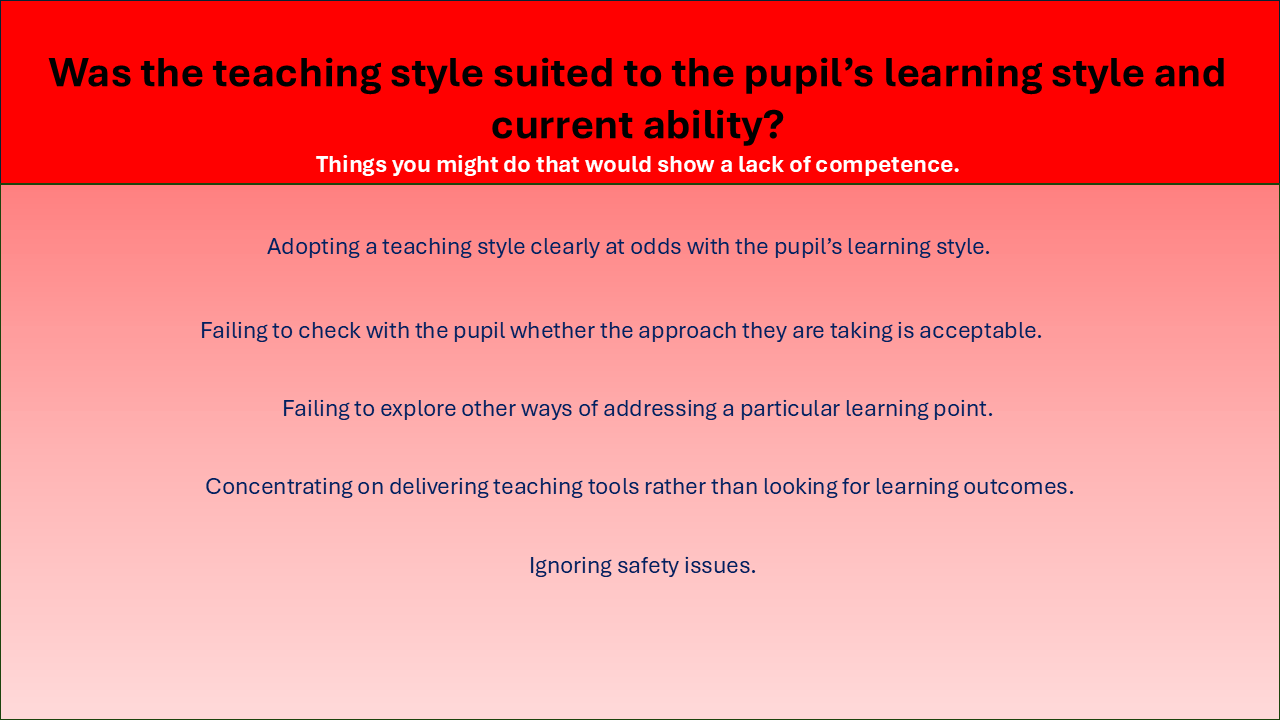
These are examples of what you should not be doing




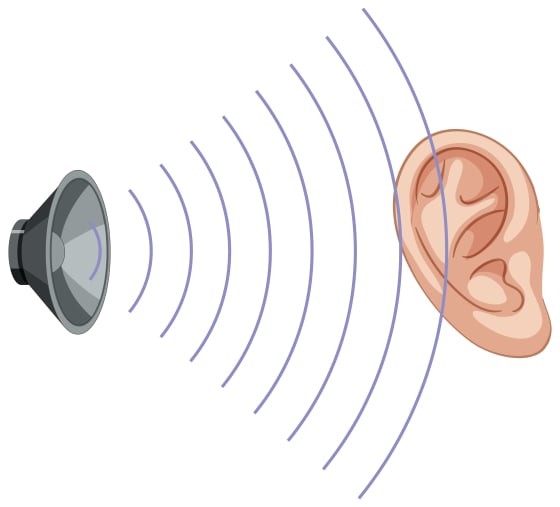
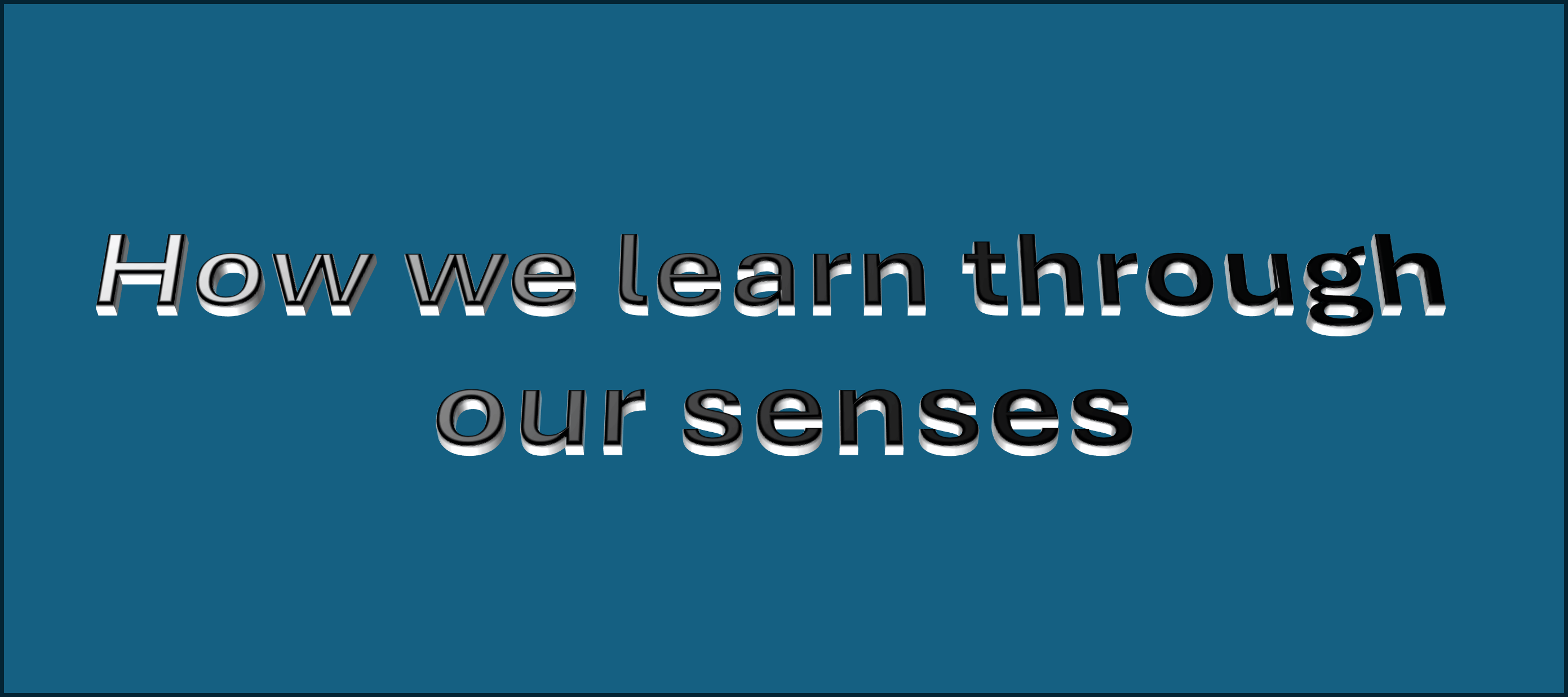
The important thing to remember when considering teaching and learning styles is that it is not just about coaching. It is about client-centred learning. Our judgement should be about whether the PDI can help the pupil to learn in an active way. Also, remember instruction based around the core competences used currently is pretty good. We must not throw that away. We are trying to increase the options available to a PDI. Coaching is a powerful extension of the range of options. It is not an automatic replacement for any of the existing ones.
There will be many times when it is useful to use a coaching technique. The principle that underpins coaching is that an engaged pupil is likely to achieve a higher level of understanding and that self-directed solutions will seem far more relevant. This applies in every situation, including instruction. Direct instruction is useful in helping a pupil in the early stages cope with new situations or supporting a pupil who is clearly struggling in a certain situation. Good coaching will use the correct technique at the correct time, matching the pupil’s needs. In some cases, the PDI may need to give direct instruction through a particularly difficult situation. That instruction forms part of a coaching process if the PDI then encourages the pupil to analyse the problem and take responsibility for learning from it. A good PDI will take every opportunity to reinforce learning.
The PDI should take into account all that they understand about the pupil. They should recognise that different pupils will have different preferred approaches to learning, although these may only emerge fully over a number of lessons. Some pupils may be very willing to learn actively and others may want opportunities to reflect before they make the next step in their learning. The PDI should at least be able to give evidence of their sensitivity to these issues. In a one-off session this will probably be best demonstrated by offering a range of options. The PDI should be able to adjust their approach if evidence emerges of a different preferred style.
It is impossible to force learning on a pupil. Progress is always determined by what the pupil is comfortable with. The skill is recognising when the pupil stops learning. The pace of a session should be set by the pupil. On the other hand a pupil should not be talked out of experimenting, if this is within safe bounds.
When coaching, the PDI should ensure that the tools used are suitable. If a question and answer technique is used this should match the pupil’s level of ability and encourage them to use a higher level of thinking to give a response. Asking closed questions of a pupil who is demonstrating a high level of ability, unless this is to check knowledge, is of little use. Asking open questions to a pupil of limited ability who is finding it difficult to achieve the task they have set for themselves may be very confusing. These are not hard and fast rules. The effectiveness of any question has to be assessed given the circumstances at the time.
If the pupil needs support and the PDI provides it, that is client centred. Conversely if the pupil needs help and the PDI does not provide it, that is not client centred and is often referred to as ‘under instruction’.
Indications that all the elements of competence are in place could include:
* Actively working to understand how they can best support the pupil’s learning process (they might not achieve a full understanding in the session – it is the attempt that demonstrates competence).
* Modifying teaching style when or if they realise there is a need to do so.
* Providing accurate and technically correct demonstration, instruction or information - giving technically incorrect instruction or information is an automatic fail if that input might lead to a safety critical situation.
* Using practical examples and other similar tools to provide different ways of looking at a particular subject.
* Linking learning in theory to learning in practice.
* Encouraging and helping the pupil to take ownership of the learning process.
* Responding to faults in a timely manner.
* Providing enough uninterrupted time to practice new skills.
* Providing the pupil with clear guidance about how they might practice outside the session.
Indications of lack of competence include:
* Adopting a teaching style clearly at odds with the pupil’s learning style.
* Failing to check with the pupil whether the approach they are taking is acceptable.
* Failing to explore other ways of addressing a particular learning point.
* Concentrating on delivering teaching tools rather than looking for learning outcomes.
* Ignoring safety issues.
The easiest way to find this out, is to ask your pupil!
It may be a case that they don't even know, therefore, it is your job to work out through adapting your teaching style to work out what works best for your pupil. For learning to drive this may then become their best learning style. It may be different for different things, but you will see what works best for them and how they can absorb, work with, grow their skills, and retain that information.
Being a good instructor, is being able to use the skills you have to adapt your teaching style to suit your pupils learning style.
Generally, most Pupil's will know how they learn best.
When driving a car, it is unlikely that your pupil is going to learn much about driving through smell or taste, but sight, sound and touch will be the most common styles.
A chef without a doubt may learn through taste and smell but unless your pupil is burning out the clutch or tasting the engine oil then it's possibly not going to be very useful for them to use smell or taste.

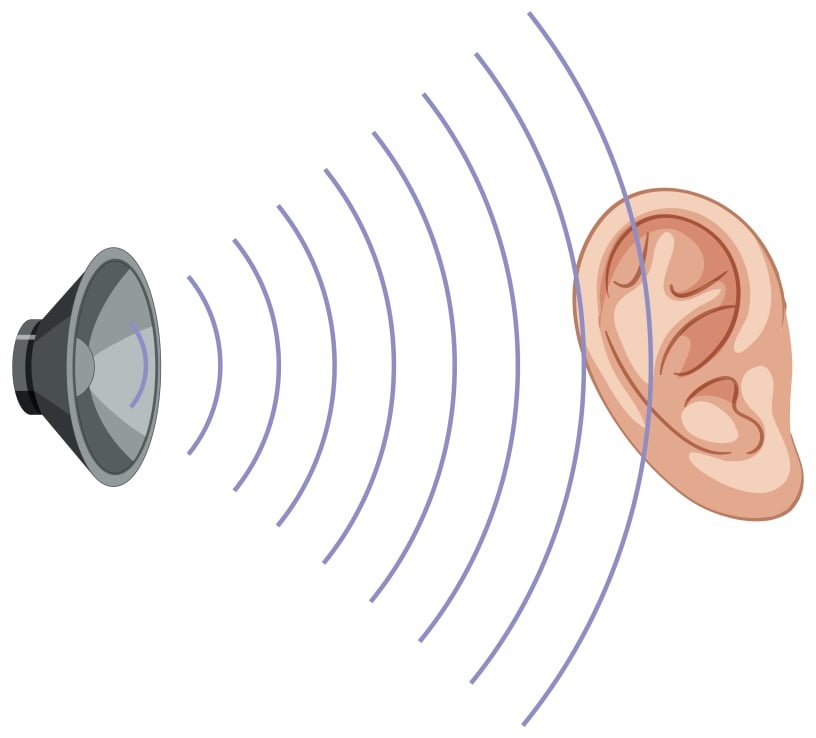

Adapting your teaching style to suit your pupils may take a little time but once you have found what works best for them you will tend to stick with it, but always be prepared to adapt that style if it is necessary.
On your first lesson with your pupil and in an attempt to start building a rapport with your pupil, you may ask them what their hobbies and interests are, based on their response and by your own intuition you may be able to gauge from this how they might learn best.
In my time as an instructor I have found that those who have good motor skills tend to learn quicker.
Those who have hobbies or interests that involve using their hands in a technical manner such as playing a guitar, drums, or are a tradesperson also tend to be quick learners.
This is because they have skills to multitask and link things together.
If you find that the manner in which you are delivering the lesson is making no difference to the outcome of the task in hand, then the teaching style you are using is probably not working and will require you to try something different.
This may mean offering a demonstration, using visual aids, dry wipe board, a video, of whatever other tools you may have to hand to assist your pupil.
If learning is taking place with relative ease, it is highly likely that you've got it right.
If you are trying something again and again (your preferred teaching style) and there appears to be no change in the outcome, then it's highly likely you're not on the right path for that particular pupil, and you will need to adapt.
Try and understand that your learner will have a preferred learning style which you need to find, but also remember you will probably have a preferred teaching style. Getting in a rut and using that same style of teaching for each pupil will not be beneficial to your pupil if learning is not taking place.
If you are becoming totally stumped after trying different methods, or even after a couple of attempts, you can always ask your pupil various questions.
"How can I help you to achieve your goal"
"Is there something I can do to help make things clearer for you?"
"Would watching a quick video on the subject help you?"
"Would giving you a demonstration help?"
It's amazing how your pupil will open up to you if you offer help and they are struggling!
If you don't offer the assistance they may feel too embarrassed to ask.
By asking them this will also help with them building a trust with you, that they know you understand them and won't hesitate in the future to ask for your help if they aren't quite getting it.
One of the biggest areas where an instructor will fall down though, is when they are trying to give instruction on something they don't exactly know about completely themselves.
It amazes me, how many instructors don't actually have a clue what a clutch looks like or how a clutch actually works.
How can you truly ask your pupil to find the "Biting point" if you don't actually fully understand what the biting point is?
You were obviously told "find the biting point" by your instructor when you learned to drive, but did they ever explain to you what is actually happening inside the engine as you raise your foot off the clutch.
If you don't understand how it works, how can you clearly explain that to your pupil?
If the information is sketchy with you, is it no wonder your pupil isn't quite getting it.
This goes for all subjects of driving!
Obviously we are not saying you need to have a degree in motor mechanics, but learning a bit more about how the vehicle actually works will put you in a good position to explain things better to your pupils.
When the information you are supplying is understood easily then you will find you have found your pupil's best learning style.
As a side note to knowing your information, for instructors to make safe drivers, they need to know their stuff!
Giving factually incorrect information to your pupil at any time is bad enough, but to do it on your Part 3 test or standards check and you'll probably be looking at an instant fail.
If you are unsure of anything that you are saying or in response to a pupils query, then you either answer it with a factually correct answer or you explain to your pupil that you are not completely sure but will check up on the answer and supply it to them when you can.
It may be that on your next pull in with them you grab a book from the boot that has that information in it, or you can give them the answer possibly on the next lesson. What you should not do is ignore the question or forget to get that information for them at some stage.